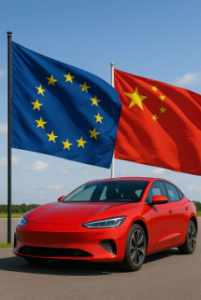In October 2024, the European Commission announced additional tariffs of up to 35% on the existing 10% duties for Chinese electric vehicles, following a months-long anti-subsidy investigation into manufacturers such as BYD and Geely. The move came amid rising tensions in EU–China trade relations, with Brussels accusing Beijing of distorting global competition through heavy state support. Since then, the issue has only intensified. China has filed a formal complaint at the World Trade Organization, threatened retaliatory measures on European wine and dairy products, and EU member states remain divided over whether the tariffs should be softened or upheld. With the important global summit COP 30 approaching, Europe has a chance to show whether it will lead the green transition through cooperation or undermine its own decarbonisation goal with the trade barriers. The decision has sparked a heated debate across Europe: is the EU defending fair competition or jeopardizing its own green transition?
Europe is sabotaging its own climate goals, because it is prioritizing the protection of its car industry over allowing affordable Chinese electric vehicles. It turns the green transition into a trade fight with China and risks slowing the green transformation it urgently needs.
Europe doesn’t need a trade war, it needs a strategy. Instead of raising tariffs on Chinese electric vehicles, the EU should establish a Green Trade Truce based on transparency, cooperation and fair competition. Brussels could invite Chinese and European producers to adhere to strict and verifiable standards on battery carbon footprints and recycled material content. In exchange, tariffs could be reduced for companies that comply. This approach would protect Europe’s interests, maintain affordable EVs for consumers, and advance climate goals.
The Commission’s new duties on Chinese EVs are trying to protect European industry from unfair subsidies and overcapacity. However, they may have the opposite effect by slowing electrification and raising costs for households. Chinese models are often 20–30 percent cheaper and are more advanced, not only because of state support. Over the past decade, China has built a tightly integrated EV ecosystem, due to their battery manufacturing, refining key materials like lithium and scaling production quickly. Furthermore, its carmakers benefit from strong domestic demand, lower labour costs, and direct access to the entire supply chain. Europe in contrast faces fragmented production, higher energy costs and a complex regulatory framework, which makes it hard to compete. Even tough tariffs may temporarily hide these weaknesses, but they do not address the underlying issues.
The irony is that Europe’s challenge is not insufficient protection, but to be innovative and be proactive. Approving new gigafactories can take years and the charging infrastructure remains underdeveloped in many areas, like Hungary or Ireland. Additionally, the high power prices for the industry in comparison to the U.S. or China, makes It difficult to match the prices. Tariffs will not fix any of these bottlenecks. A smarter policy would focus on accelerating domestic competitiveness. With faster approvals, cheaper green power and coordinated incentives for battery innovation. This approach has proven effective elsewhere: China’s rise in the EV sector was built on clear industrial targets, massive R&D support, and scale-oriented subsidies, while the U.S. Inflation Reduction Act shows how targeted incentives can mobilize private investment. Europe can succeed the same way, by designing incentives that reward innovation and scale, rather than defaulting to protectionism.
Of course, Europe shouldn’t just accept unfair trade, because Chinese EV makers benefit from extensive state subsidies, cheap credits, and below-market access to raw materials, which gives them an artificial cost advantage that undermines free competition. That is precisely what the Commission’s 2023 anti-subsidy probe wants to address. If the Commission can prove that certain Chinese carmakers benefit from heavy state subsidies, then a measured response with for example targeted tariffs is a legitimate option. However, just using duties on every import is a naïve weapon, which invites retaliation, disrupts global supply chains, and undermines Europe’s image as a defender of fair and open trade. Moreover, it exposes a double standard: Europe wants to claim climate leadership and demands global cooperation on carbon reduction, yet at the same time uses tariffs on affordable electric cars from China, which reduces their availability and slows EV adoption.
An approach which prioritizes standards would turn Europe’s regulatory strength into a competitive advantage. Without protectionism Brussels can raise the bar for everyone with transparent rules for battery sourcing and recyclability. Countries that meet those rules can access the European market freely; those that don’t would face penalties based on measurable environmental criteria. This model rewards innovation and compliance rather than political leverage and supports the desired climate goals.
The urgency is clear. Every tariff that slows EV adoption pushes Europe further from its 2030 emissions goals. With the EU currently finalising its next industrial competitiveness strategy and COP30 approaching, the window for credible climate leadership is closing fast. Europe can now decide if it wants to spend the next decade on trade disputes or focus on building clean-tech capacity. The EU should choose cooperation over confrontation and standards over sanctions. Climate change won’t wait. Europe must invent the future and not defend the past.



1 comment
16 October, 2025 @ 19:39 Kiara
What an amazing and reflective approach to analyse EU-China economic relations! Your contribution truly reflects well-researched data and contains a constructive analysis. I am looking forward to read more from you!